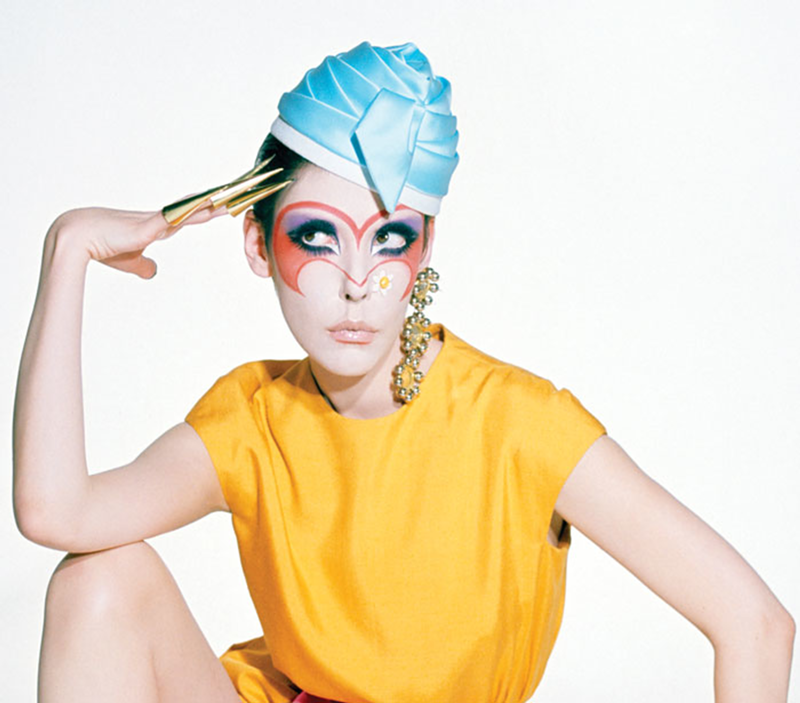The star attraction of The Total Look, the new Cincinnati Art Museum exhibit opening Saturday that features fashion designs of the late Rudi Gernreich, is the one-piece topless bathing suit (or monokini) that he designed for women in 1964. It created as much controversy in its time as an Andy Warhol soup can or The Beatles’ long hair — and is still pretty daring to this day.
On a mannequin in the museum’s newly named second-floor Western & Southern Gallery, its radicalness sneaks up on you, certainly compared to the bolder bright colors and exotic patterns of much of his other fashions on display. It looks like a tight pair of black, slightly high-waisted bicycle shorts with two thin straps that rise up between the breasts and over the shoulders.
According to Cynthia Amneus, the art museum’s curator of fashion arts and textiles (and also chief curator), its notoriety took Gernreich by surprise in 1964. He had never really meant for it to be taken as seriously as it was.
“The topless suit was simply a prediction,” Amneus says. “A magazine editor said, ‘What do you think will be coming up in swimwear in the future?’ and he said, ‘I think in five years we’ll have topless.’
“He didn’t plan to produce it, but he was pushed once he made that prediction by magazine editors to produce one to show what it would look like. So he did and it was photographed and stores wanted it. It became what he was known for and he was very frustrated by it.”
“There were women who wore it,” Amneus continues. “He sold about 3000 of it. But he didn’t expect it to be something women would be wearing in public. It was something for their home pool.”
Born in Austria in 1922 and a Jewish refugee from Hitler’s 1938 annexation of that country, he settled in Los Angeles and started designing fashions in the 1950s. (He died in 1985.)
By 1964, he already was a top fashion designer, especially of one-piece swimsuits, which he wanted to pare away at with portholes and other innovations to liberate the bodies they covered.
His fame was greatly aided by his stylish, Modish model Peggy Moffitt, who was dynamically photographed wearing his designs by her husband, William Claxton. Indeed, the photo of Moffitt wearing the monokini — it’s in this show — helped make it famous.
Because this traveling exhibit mostly comes from Moffitt’s own collection, and includes photos (and a video) by Claxton, its full title is The Total Look: The Creative Collaboration Between Rudi Gernreich, Peggy Moffitt and William Claxton. It is up through May 24.
This show was organized by Cameron Silver, owner of Los Angeles vintage fashion shop Decades. It debuted at the Pacific Design Center branch of The Museum of Contemporary Art, Los Angeles, and then traveled to the museum of Savannah College of Art and Design. Here, it includes 60 pieces from Moffitt’s own collection as well as eight from the museum’s own holdings, including a “no-bra bra,” the first soft, transparent bra.
The Cincinnati show also includes 13 photographs of hairstyles by Vidal Sassoon, the 1960s-defining hairdresser who died in 2012 and who styled Moffitt’s striking bowl cut.
Gernreich’s flair for the provocative veered toward the theatrical. There are numerous examples in the show — printed-silk caftans in resplendent colors meant to be worn by men or women, a sleek black-jersey evening halter top with pants that hang from a silver metal collar designed by Christopher den Blaker, and several outfits with stenciled animal prints with matching hoods, jackets, skirts, dresses and “glittens” (combination gloves and mittens).
Gernreich’s work also had a more overtly political side. In this show is one piece from a shocking 1971 collection of military-inspired wear that he introduced by having models wear dog tags and carry guns with it. It was a response to the times — the disastrous Vietnam War and the massacre of Kent State University students.
“He was saying, ‘I’m not going to [offer] fantasy fashion we can all have fun with — we need to be paying attention to what’s going on in society,’” Amneus says. “It was very much a political statement. He was so avant-garde.”
THE TOTAL LOOK opens Saturday at the Cincinnati Art Museum and continues through May 24. More info: cincinnatiartmuseum.org.






